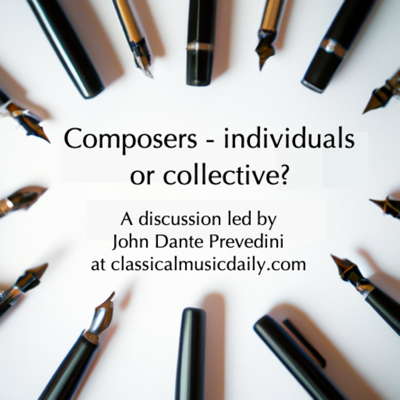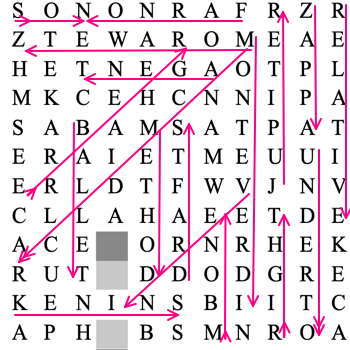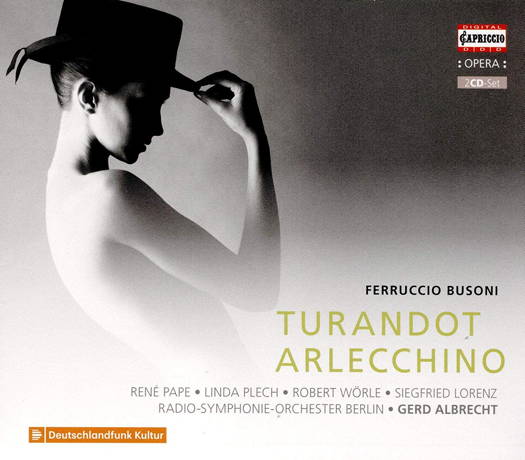 DISCUSSION: John Dante Prevedini leads a discussion about Composers, individuals or collective?, including contributions from David Arditti, Halida Dinova, Robert McCarney and Jane Stanley.
DISCUSSION: John Dante Prevedini leads a discussion about Composers, individuals or collective?, including contributions from David Arditti, Halida Dinova, Robert McCarney and Jane Stanley.
 WORD SEARCH: Can you solve Allan Rae's classical music word search puzzles? We're currently publishing one per month.
WORD SEARCH: Can you solve Allan Rae's classical music word search puzzles? We're currently publishing one per month.
 VIDEO PODCAST: John Dante Prevedini leads a discussion about The Creative Spark, including contributions from Ryan Ash, Sean Neukom, Adrian Rumson, Stephen Francis Vasta, David Arditti, Halida Dinova and Andrew Arceci.
VIDEO PODCAST: John Dante Prevedini leads a discussion about The Creative Spark, including contributions from Ryan Ash, Sean Neukom, Adrian Rumson, Stephen Francis Vasta, David Arditti, Halida Dinova and Andrew Arceci.

The Charm of 'La Nuova Commedia Dell'arte'
GIUSEPPE PENNISI listens to
Busoni's 'Turandot' and 'Arlecchino'
'... a delightful and interesting double CD.'
This CD is a remastered new issue of two Capriccio CDs firstly published in 1993 and now hard to find and purchase. To make a new issue is a good idea because there is interest in Busoni's attempts to revive la commedia dell'arte about a hundred years ago, when opera and musical theatre in general were searching new venues.
Ferruccio Busoni (1866-1924) is known especially as a pianist and a piano and chamber music composer. However, his four operas - the last, Doktor Faust, premiered posthumously - are important and innovative, even though they are seldom staged. I had the luck of seeing and hearing Turandot twice: at Verona Teatro Filarmonico in 1980 and at Cagliari's Teatro Lirico in 2018 - the performance reviewed in Music & Vision on 5 March 2018, and Arlecchino and Doktor Faust at Bologna Teatro Comunale in, respectively, 2006 and 1985. In fact, productions of these operas are rare and far between. I do not know of any recent production of Die Brautwahl, premiered in Hamburg in 1912.
A few words on the composer. Busoni was born in Empoli (near Florence), son of an Italian clarinet virtuoso and of a mother of German descent, Alma Weiss, from Trieste. He was a child prodigy: his first piano recital was in Trieste in 1873. He studied in Vienna and settled in Leipzig in 1886, trying to make a name as a pianist and as a composer. As a professor of piano, he worked in Helsinki, Moscow and New York before making Berlin his permanent residence in 1894. He composed piano and violin sonatas and wrote Sketch of a new esthetic of music.
Only later in life did he approach theatre, by providing music for a Max Reinhart production of Carlo Gozzi's Turandot, premiered in 1905. During World War I, he moved to neutral Switzerland with his family. There, he remodelled the Turandot music into a short opera in two acts, and conceived Arlecchino as a one act opera.
The two operas had their debuts in Zurich on 11 May 1917. They are attempts to create the nuova commedia dell'arte, based on Gozzi's interpretation of la commedia dell'arte, but with a German flavour. A perfect match for the bicultural Busoni. He was not alone in searching a new path for opera in la commedia dell'arte: think of Alfredo Casella's La donna serpente (The Snake Woman), whose recent revival was reviewed in Music & Vision on 18 April 2016.
The CD features Gerd Albrecht as conductor, Radio-Symphonie Orchester Berlin, Rias-Kammerchor and an excellent cast: René Pape, Linda Plech, Gabriele Schreckenbach, Josef Protschka as principals of Turandot, and Peter Matič, René Pape and Marcia Bellamy as protagonists of Arlecchino.
Let us start with Turandot. It is completely different from Puccini's later setting of Gozzi's play. It is highly stylized and characterized by very short musical numbers, as one can sense from the prelude and the entrance duet.
Listen — Busoni: Orchestral prelude/Peking Stadt der Wunder (Turandot, Act I)
(CD1 track 1, 0:54-track 2, 0:35) © 1993/2020 Capriccio Records :
Humour arrives when the commedia dell'arte characters come in.
Listen — Busoni: Rechts zunächst der große Thron (Turandot, Act I)
(CD1 track 6, 0:52-1:42) © 1993/2020 Capriccio Records :
It also pervades the aria of Emperor Altoum.
The march and scene are quite hilarious.
Listen — Busoni: March and Scene (Turandot, Act I)
(CD1 track 13, 4:54-5:52) © 1993/2020 Capriccio Records :
While the finale of the first act is a melodious tenor aria.
The drama emerges in the second act, especially in Turandot's aria:
Listen — Busoni: Genug! Mein Kopf (Turandot, Act II)
(CD1 track 19, 0:00-0:54) © 1993/2020 Capriccio Records :
The final tableau, however, is full of happiness.
Arlecchino is more akin to a commedia dell'arte farce (as read by Germans) from the very beginning:
Listen — Busoni: Introduction (Arlecchino, Part I)
(CD2 track 1, 2:30-3:23) © 1993/2020 Capriccio Records :
The love scene is full of humour too.
Listen — Busoni: Herr Kapitän, um Vergebung (Arlecchino, Part III)
(CD2 track 5, 1:01-1:54) © 1993/2020 Capriccio Records :
The double finale is a march and dance, followed by a rondo.
Listen — Busoni: Rondo arlecchinesco, Op 46
(CD2 track 10, 10:33-11:26) © 1993/2020 Capriccio Records :
While in Turandot the listener can sense the composer's inner conflict between his two homelands, Arlecchino is purely German music of the start of the nineteenth century.
In short, a delightful and interesting double CD.
Copyright © 26 March 2020
Giuseppe Pennisi,
Rome, Italy

CD INFORMATION: FERRUCCIO BUSONI: TURANDOT; ARLECCHINO
FURTHER INFORMATION: FERRUCCIO BUSONI
FURTHER INFORMATION: CAPRICCIO RECORDS


